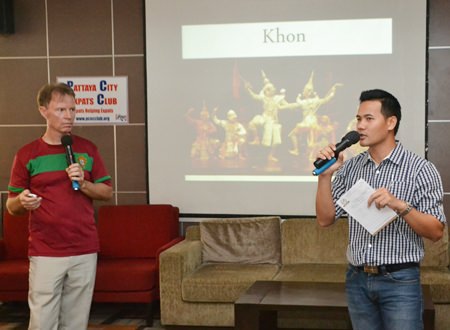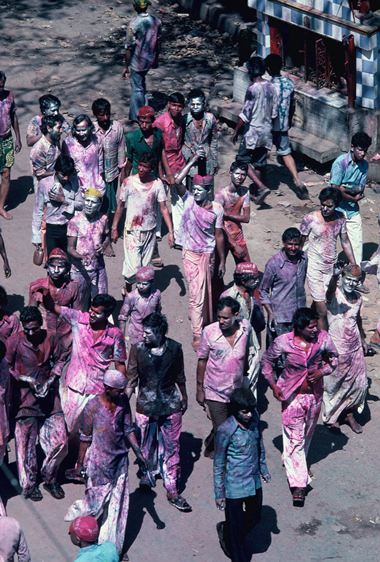A journey of the galaxy, with stops along the way at the international space station, various planets, the Sun, the asteroid belt and other star systems was provided at the Sunday, January 24, meeting of the Pattaya City Expats Club.
The guide was Günther Worthmann, who has had a long career as a space engineer, including serving as a manager in the German Space Program in the 1990s. He was born in Bremen, Germany and has a Bachelor’s degree and Master of Science degree from Germany. He worked as an engineer on a number of projects related to space. His last job before he retired was as a consultant for the Airbus-Industry A380 Program.
 Günther Worthmann, who worked in Space Programs before retiring, introduces his topic Space, Sun, Moon, and Stars at the beginning of his presentation to the PCEC.
Günther Worthmann, who worked in Space Programs before retiring, introduces his topic Space, Sun, Moon, and Stars at the beginning of his presentation to the PCEC.
People have been studying the stars and the universe for 5,000 years, Günther explained. Further, the last 50 years have brought us more knowledge about the universe than the previous 4,950 years. He mentioned that in the early 16th century, Ferdinand Magellan explored the Pacific Ocean using astronomical navigation guides to find his way; the Southern Cross (a constellation of stars that is part of the Milky Way) and a duo of irregular dwarf galaxies visible from the southern hemisphere, which have become known as the Magellan Cloud. Also, Nicolaus Copernicus, Galilei Galileo and Johannes Kepler contributed to our knowledge by determining the arrangement of the planets that circled around the Sun. Additionally, discoveries by Ole Römer, Albert Einstein and Isaac Newton contributed to our understanding of the universe.
 Günther Worthmann acquaints his audience with the characteristics of the nine planets in Earth’s Solar System during his presentation at the Sunday PCEC meeting.
Günther Worthmann acquaints his audience with the characteristics of the nine planets in Earth’s Solar System during his presentation at the Sunday PCEC meeting.
He mentioned that actual exploration of space started in 1957 when a capsule containing a dog was launched into orbit by Russia, soon to be followed by humans orbiting the earth and, in 1969, American Astronauts walked on the Moon. Now, he said, there are an untold number of satellites in space, many of them being used for telecommunications. Günther explained how gravitational pull and centrifugal force kept them in stationary orbit around the earth at height of 35,900 km.
 MC Roy Albiston presents Günther Worthmann the PCEC’s Certificate of Appreciation for his talk about the space program, solar system, and stars.
MC Roy Albiston presents Günther Worthmann the PCEC’s Certificate of Appreciation for his talk about the space program, solar system, and stars.
He commented on the space shuttle which, as he put it, “is now in retirement,” to be replaced by a new type of spacecraft that will have re-usable rockets. Günther also talked about his work with the European company OHB SE in Bremen, Germany, that develops and manufactures space systems and satellites; including having a special dust-free Integration Hall to assemble satellites.
Günther talked about his work at the Kennedy Space Center in Florida, where he was for more than 10 years a chief engineer working on scientific experiments for the International Space Station (ISS). The ISS was built by the U.S., but several countries contributed portions of the station. He explained how, unlike communication satellites, it is in a low orbit of about 400 kilometres above the earth; moving at a speed of 28,000 kilometres an hour, the space station takes 90-minutes to complete a journey around the Earth.
 Member Ren Lexander interviews Günther Worthmann after his presentation to the PCEC. The video can be viewed at https://www.youtube.com/watch?v=TuaHVqQ5Ng4.
Member Ren Lexander interviews Günther Worthmann after his presentation to the PCEC. The video can be viewed at https://www.youtube.com/watch?v=TuaHVqQ5Ng4.
After speaking on the space program, Günther then went on to talk about the Solar System providing information about the Sun, planets, asteroids, and comets. The Sun, which is just one of many stars in the universe, is 4.5 billion years old, the same as the Earth. The core of the sun is 15.6 million degrees Celsius. The outer surface of the sun is much cooler, at about 5,500 degrees Celsius. The Sun is one million times bigger than the Earth. From the Sun to the Earth is about 150 million kilometres. From the Earth to Mars, the next furthest planet from the Sun, is 17 million kilometres. With today’s technology, it would take us about nine months to get there. A year on Mars lasts 500 days.
 Emilie Fowler, a volunteer with the Willpower Institute Meditation Centre, uses the PCEC Open Forum to announce a free one day English meditation course to introduce people to the benefits of meditation and how it can enhance both your personal and professional life.
Emilie Fowler, a volunteer with the Willpower Institute Meditation Centre, uses the PCEC Open Forum to announce a free one day English meditation course to introduce people to the benefits of meditation and how it can enhance both your personal and professional life.
Günther said that beyond Mars there is an Asteroid Belt which could be very dangerous for the Earth. Asteroids are very large objects between 50 metres and 200 metres in diameter, though some are even larger. They are made up of rock and metal. An asteroid that hit the Earth about 65 million years ago is believed to have wiped out the dinosaur population. Meteoroids are similar to asteroids, but under 50 metres in diameter. Günther then proceeded on to the Galaxy, ours being the Milky Way. The nearest star system to the Earth is the Proxima Centaur, Günther said. It would take us 20,000 years to fly there.
 Nine PCEC members from Australia reminded everyone that Australia Day was Tuesday, January 26. In commemoration of this great day for Australians, a cube of a popular Australian cake was distributed to members and guests during the PCEC meeting.
Nine PCEC members from Australia reminded everyone that Australia Day was Tuesday, January 26. In commemoration of this great day for Australians, a cube of a popular Australian cake was distributed to members and guests during the PCEC meeting.
At the conclusion of the presentation, MC Roy Albiston brought everyone up to date on club and other events and called on Stuart Saunders to conduct the Open Forum, where questions are asked and answered about expat living in Thailand, especially Pattaya.
For more information on the PCEC’s many activities, visit their website at www.pcecclub.org.




